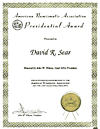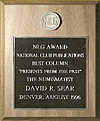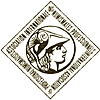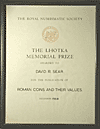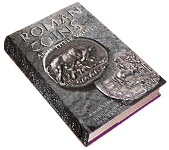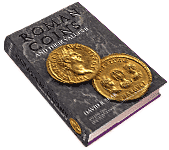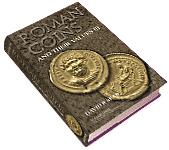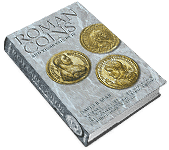 |
As many visitors to this site will already be aware, I have authored an extensive series of books over the past four and a half decades aimed at covering the entire spectrum of ancient numismatics, from the beginnings of coinage in western Asia Minor around 600 BC to the fall of the Byzantine Empire in 1453. My goal has been to present seemingly complex subject matter in a simple and usable form, and thereby encourage people to take up a hobby which can provide endless fascination and ultimately lead to a deeper understanding of our past. I have had the gratification of hearing from many numismatists over the years that my books were responsible for their initial involvement in the subject. Many of these works are still available in their most recent editions and I invite you to order them directly from me. Full details of each publication appear on the following pages and I will be happy to autograph and personally dedicate copies ordered on this site.
 
This new series is intended to provide a general background to the fascinating world of ancient coins, originating more than 26 centuries ago in western Asia Minor and spanning 1,100 years down to the fall of the Western Roman Empire in the late fifth century A.D. It is not primarily a catalogue listing of types, but rather an explanation of how coinage evolved in the Mediterranean basin throughout the Graeco-Roman period. It is profusely illustrated in the text with coin images, almost exclusively in color, and includes a wealth of historical and geographical information. The first of a three-volume series, Volume I covers the civic coinages of the Greek cities and tribal issues of the Celts and other peoples down to the first century B.C. The second volume, now available, covers the issues of the great Hellenistic monarchies down to their absorption into the ever-expanding Roman state. The third volume, which is currently in preparation, will describe the history and development of the Roman coinage from its origins in the early third century B.C. and will include a survey of the provincial issues, commonly known as the "Greek Imperial" series. Each volume will contain a useful chronological table, a glossary of terms that may be unfamiliar to the novice collector, a series of maps, and an index of inscriptions to aid identification.

 |
 |
 
My first book, ROMAN COINS AND THEIR VALUES, was published by B. A. Seaby Ltd. in 1964 and was awarded the Lhotka Memorial Prize by the Royal Numismatic Society in London. It has since been through a number of revisions, the most recent being the Fourth Revised Edition which appeared in 1988 (reprints still available). In recent years I have been working on the entirely new 'Millennium Edition', the fifth and final volume of which has recently been finished. The series is now complete, from the earliest Republican issues down to the death of the Eastern Emperor Zeno in A.D. 491. It is with the accession of Anastasius I and his fundamental reform of the bronze coinage that the Byzantine series is generally held to commence.

 
BYZANTINE COINS AND THEIR VALUES, the second of my books to appear in print, deals with the lesser-known subject of the Christian Roman Empire in the East, from the reign of Anastasius I (AD 491 - 518) to the fall of Constantinople to the Turks under the Ottoman Sultan Mohammed II on May 29, 1453. The original edition was published in 1974 , but was extensively revised and expanded in the current (1988) edition. This catalogue has the added virtue of including virtually every known type of this intriguing series, together with a chapter which describes and illustrates many of the modern forgeries of Byzantine coins which have appeared on the market in recent decades.

 
My third published work was GREEK COINS AND THEIR VALUES which appeared in two volumes in 1978 and 1979. Volume 1 covers the issues of Greek mints in Europe and includes related series, such as the Celtic coinages of Britain, Gaul, and the Balkans.
Volume 2 provides the same coverage for mints in Asia and Africa, and includes a comprehensive listing of the coinages of the great Hellenistic monarchies of the post-Alexander era, down to the fall of the Ptolemaic Kingdom of Egypt in 30 BC.

 
Next to be published was GREEK IMPERIAL COINS AND THEIR VALUES (1982) which was awarded the 1983 Book Prize by the International Association of Professional Numismatists (IAPN). In this catalogue I broke new ground by providing collectors with a chronological overview of the provincial coinage of the Roman Empire, produced for local circulation by Greek mints and Roman colonial foundations. As such it provides a perfect companion volume to both Roman Coins and Their Values and Greek Coins and Their Values. Also included are the contemporary coinages of independent and semi-independent states, such as the Arsacid kingdom of Parthia and the Herodian dynasty in Judaea.


49-27 B.C.

This single-volume work appeared as a Spink Publication in 1998 and was awarded an IAPN Book Prize. It represented a radical departure from the pattern of my previous works, being a detailed historical narrative of the period which witnessed the transition from Republic to Empire in the Roman world. Interwoven with the chronicle of events is a complete type catalogue of all the coins issued during this brief, but violent, phase of Roman history.

 
The five-volume set of ROMAN SILVER COINS, though not authored by me, is a work with which I have been closely involved over the years through its various revisions. The idea of a complete type catalogue of the Roman Republican and Imperial silver denominations was originally conceived by Herbert Seaby, founder of the London coin company B. A. Seaby Ltd. Volume I, covering the Republic through Augustus, first appeared in 1952 and was followed two years later by Volume II (Tiberius to Commodus). The most recent revisions of each appeared in 1978 and 1979 respectively. Volume III (Pertinax to Balbinus and Pupienus) was published in 1969 and revised in 1982; whilst Volume IV (Gordian III to Postumus) appeared in 1971 and was also revised in 1982. The final book in the series, Volume V (Carausius to Romulus Augustus) was authored by Dr. C.E. King of the Ashmolean Museum, Oxford, and was published in 1987. The full set covers about 770 years of Roman silver coinage and is an indispensable source of information for the serious collector.

|
 |

